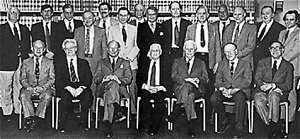|
By Professor Jon Cavicchi, J.D., LL.M. (I.P.) In March 2003 I received several calls from Patti Young at the Patent Office Search Facilities. She had been contacted by an Inventor who had submitted an idea to help the World War II war effort. He submitted the idea to the National inventors Council. Neither she nor I had heard of citizen invention disclosures and files outside the Patent Office System. She called me because the only reference on the Web she had found was ptcforum.org which indicated that the NIC had been transferred to the public sector in 1973 under the auspices of the Academy of Applied Science and the Franklin Pierce Law Center. She had assumed that the files would be located in the Pierce Law Intellectual Property Library. I had no clue. Our senior IP Faculty had no clue. Our founder, Dr. Robert Rines, declined to answer my phone call. He indicated through his secretary that he had no idea as to the location of the invention disclosure files. Over the following days I traced the path of these files from the Commerce Department to the National Bureau of Standards to the National Archives. What I discovered raises many questions. I spoke with Marjorie Ciarlante at NARA. My goal was to ascertain the extent of the collection to study the feasibility of scanning and posting the invention disclosures and the files on the IP Mall Website. Through Ms. Ciarlante and documentation she sent me I found that these documents have been classified and that portions of the collection are missing. Why are these documents classified? Where are the missing files? When will they enter the public domain? According to NARA records : "As late as 1988, the National Bureau of Standards Records Officer Bernie Hale, reiterated this position, saying that the records could not be opened to the public "until after the turn of the century." The value of these records for research into the history of science and technology is undisputed, and these records are especially significant considering the impact of technology on WW II." It is now beyond the turn of the century and this information is still locked down at NARA. I spoke with an Assistant General Counsel at NARA. She is looking into this matter but assures me that the process of declassifying these files is not a quick or easy process. The National Inventors Council During W.W.II, the National Inventors Council (NIC) came into being due to the recognition that inventions and ideas of U.S. citizenry could play an important role in the war effort. From the noble beginnings of producing ideas, such as a small mercury dry cell battery with a two-month life for walkie-talkie use a mirror signaling device for downed pilots; a substitute for kapok life jackets, the National Inventors Council continued as the only technology transfer link between the citizenry and the military and other government agencies. During 1973, the NIC, then at the National Bureau of Standards, was transferred to the private sector under the auspices of the Academy of Applied Science and the Franklin Pierce Law Center. The focus was shifted from trying to answer the specific needs of a special group to developing a generalized approach to investigating the realm of innovation and invention. Since that time, the NIC's goal has been to continue to help solve problems associated with technological creativity and transfer, particularly with those groups historically responsible for breakthrough innovations: universities and independent inventors. In 1986, the NIC began a new phase of its continuing pursuit to assist technological innovation. Under the impetus of a new patent law program in the People's Republic of China, the Academy was asked to assist Chinese universities and independent inventors in bringing their ideas to American businesses. This assistance would also involve an information exchange to enable Chinese inventors to better understand the markets that they were trying to enter. This venture was developed under the aegis of a program called PACT, an acronym for Promotion of American Chinese Technology. Like its progenitor, the NIC, which has continued to expand its charter, PACT has found that its acronym can now stand for Promotion of Advanced Commercial Technologies. PACT became a natural outgrowth of the NIC as part of its activities, particularly as it has come to aid not only Chinese universities and ministries in protecting and licensing or otherwise commercializing upon their inventions and technologies, hopefully with American companies, but also faculty and graduate students of American and United Kingdom universities, as well - and an occasional independent inventor or small company. |
Remote Sector reorganizing charter members of the National Inventors' Council and the Academy of Applied Science who attended the 1981 Inventors Conference (pictured in the Franklin Pierce Law Center Library). Seated (left to right) Alan A. Smith, Donald B. Sinclair, Brooks Walker, Charles Stark Draper, Richard Walton, Kenneth J. Germeshausen, and Harry Saragovitz. Standing (left to right) Draper Harvey, Hugh Brett, John Lothrop, Isaac S. Blonder, Duane Marshall, Charles W. Wyckoff, William Yates, Lamar Washington, Nelson H. Shapiro, Jason Weisman, Samuel Nakasian, Robert H. Rines, Howard S. Curtis, Kenan Sahin. The History of the NIC Files from NARA - National Institute of Standards and Technology WNRC Project
|


